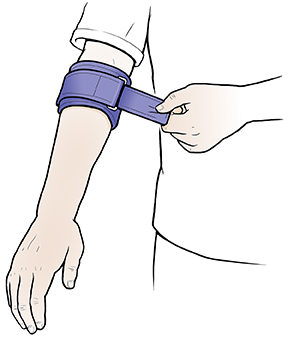Tennis Elbow
Muscles connect to bones by thick, fibrous cords (tendons). When the muscles are overused by repeated motion, the tendons may become inflamed and painful. This condition is called tendonitis.
Tennis elbow (lateral epicondylitis) is a form of tendonitis. It occurs when the forearm muscles are used again and again in a twisting motion. Pain from tennis elbow occurs mainly on the outside of the elbow. But the pain can spread into the forearm and wrist. Your elbow may also be swollen and tender to the touch.
The pain may get worse when you move your arm or do certain activities. Bending your wrist back, shaking hands, or turning a doorknob may cause pain. The pain often gets worse after several weeks or months. Sometimes you may feel pain when your arm is still.
Tennis players who use a backhand stroke with poor technique are more likely to get tennis elbow. But playing tennis is only one cause of tennis elbow. Other common activities that can cause it include:
-
Hammering
-
Painting
-
Raking
Besides tennis players, people at risk include carpenters, gardeners, musicians, and dentists. Sometimes people get tennis elbow without doing anything that would cause the injury.
Treatment includes resting the arm and taking anti-inflammatory medicines. Special splints can help ease symptoms. Symptoms should get better after 4 to 6 weeks of rest. You may need steroid injections if resting and using a splint don’t help. After the pain is relieved, you should change your activities so the symptoms don’t return. You may need physical therapy. It may include stretching, range-of-motion, and strengthening exercises. These treatments help in most cases. You may need surgery if your symptoms continue for 6 months despite treatment.

Home care
Follow these guidelines when caring for yourself at home:
-
Rest your elbow as needed. Protect it from movement that causes pain. You may be told to use a forearm splint at night to ease symptoms in the morning. Your healthcare provider may recommend a special wrap or splint to compress the muscles of the forearm. This can ease pain during daytime activities. As your symptoms get better, start to move your elbow more.
-
Put an ice pack on the injured area. Do this for 20 minutes every 1 to 2 hours the first day for pain relief. You can make an ice pack by wrapping a plastic bag of ice cubes in a thin towel. Continue using the ice pack 3 to 4 times a day for the next several days. Then use the ice pack as needed to ease pain and swelling.
-
You may use acetaminophen or ibuprofen to control pain, unless another pain medicine was prescribed. If you have chronic liver or kidney disease, talk with your healthcare provider before using these medicines. Also talk with your provider if you’ve had a stomach ulcer or gastrointestinal bleeding.
-
After your elbow heals, avoid the motion that caused your pain. Or learn to move in a way that causes less stress on the tendon. Using a forearm wrap may keep tennis elbow from happening again.
-
A tennis elbow strap may ease pain and keep you from further injury when you start playing tennis again. You can also lower your risk for injury by warming up before you play and cooling down afterward. You should also use the right equipment. For instance, make sure your racquet has the right grip and is the right size for you.
Follow-up care
Follow up with your healthcare provider as advised, or if your symptoms don’t get better after 2 to 3 weeks of treatment.
When to seek medical advice
Call your healthcare provider right away if any of these occur:
-
Redness over the painful area
-
Pain, stiffness, or swelling at the elbow gets worse
-
Any numbness or tingling in your arm, hands, or fingers
-
Unexplained fever of 100.4ºF (38ºC) or higher, or as directed by your healthcare provider
-
Chills